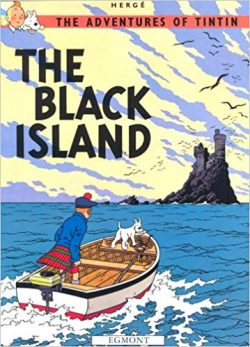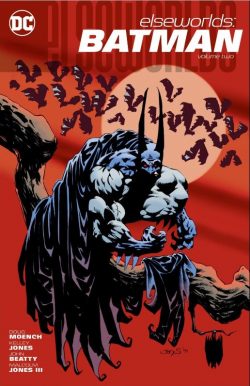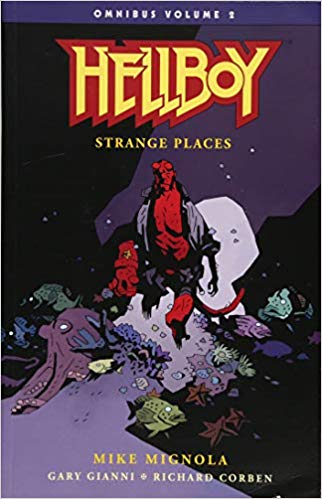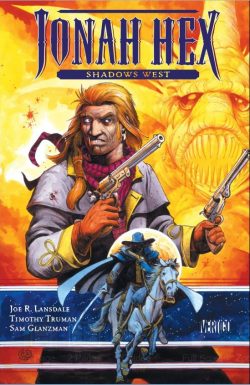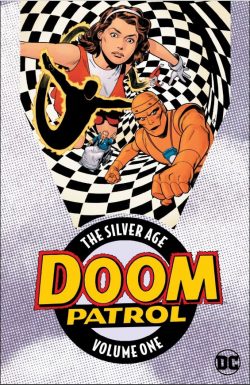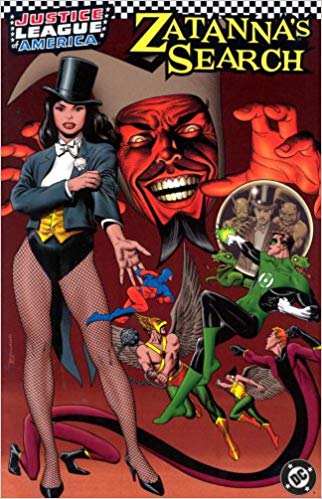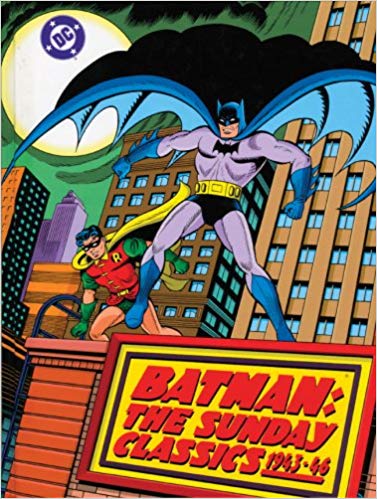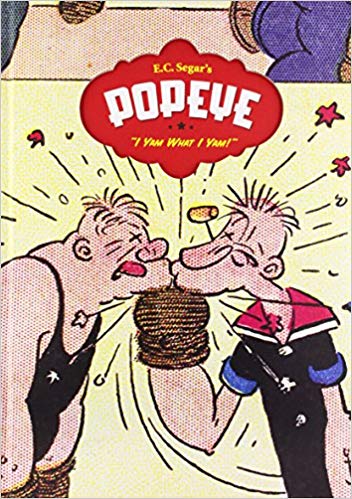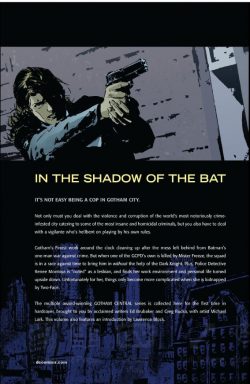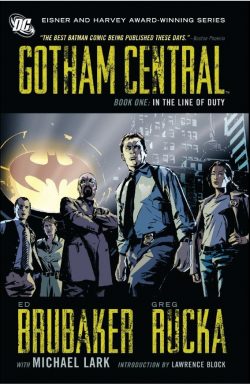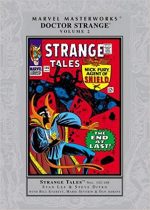

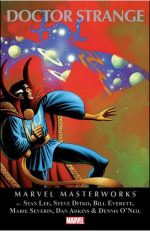
By Stan Lee, Steve Ditko, Dennis O’Neil, Roy Thomas, Raymond Marais, Jim Lawrence, Dan Adkins, Bill Everett, Marie Severin, George Tuska & various (Marvel)
ISBN: 978-0-7851-1737-7 (HB)Â Â Â Â Â Â Â Â Â Â Â Â Â Â Â Â Â Â Â 978-0-7851-6770-9 (TPB)
Win’s Christmas Gift Recommendation: A Modicum More Merry Seasonal Magic… 9/10
When the budding House of Ideas introduced a warrior wizard to their burgeoning pantheon in the summer of 1963 it was a bold and curious move. Bizarre adventures and menacing monsters were still incredibly popular but mention of magic or the supernatural – especially vampires, werewolves and their eldritch ilk – were harshly proscribed by a censorship panel which dictated almost all aspects of story content.
At this time – almost a decade after a public witch hunt led to Senate hearings – all comics were ferociously monitored and adjudicated by the draconian Comics Code Authority. Even though the some of the small company’s strongest sellers were still mystery and monster mags, their underlying themes and premises were almost universally mad science and alien wonders, not necromantic or thaumaturgic horrors.
That might explain Stan Lee’s low-key introduction of Steve Ditko’s mystic adventurer: an exotic, twilit troubleshooter inhabiting the shadowy outer fringes of rational, civilised society.
Capitalising on of the runaway success of Fantastic Four, Lee had quickly spun off the youngest, most colourful member of the team into his own series, hoping to recapture the glory of the 1940s when the Human Torch was one of the company’s untouchable “Big Three†superstars.
Within a year of FF #1, anthology title Strange Tales became home for the blazing boy-hero (beginning with issue #101, cover-dated October 1962): launching Johnny Storm on a creatively productive but commercially unsuccessful solo career.
Soon after in Tales of Suspense #41 (May 1963) current sensation Iron Man battled a crazed technological wizard dubbed Doctor Strange, and with the name successfully and legally in copyrightable print (a long-established Lee technique: Thorr, The Thing, Magneto and the Hulk had been disposable Atlas “furry underpants monsters†long before they became in-continuity Marvel characters) preparations began for a new and truly different kind of hero.
The company had already recently published a quasi-mystic precursor: balding, trench-coated savant Doctor Droom – later rechristened (or is that re-paganed?) Dr. Druid – had an inconspicuous short run in Amazing Adventures (volume 1 #1-4 & #6: June-November 1961). He was a balding psychiatrist, sage and paranormal investigator who tackled everything from alien invaders to Atlanteans. He was subsequently retro-written into Marvel continuity as an alternative candidate and precursor for Stephen Strange‘s ultimate role as Sorcerer Supreme…
Nevertheless, after a shaky start, the Marvel Age Master of the Mystic Arts became an unmissable icon of the cool counter-culture kids who saw in Ditko’s increasingly psychedelic art echoes and overtones of their own trippy explorations of other worlds and realms…
That might not have been the authors’ intentions but it certainly helped keep the mage at the forefront of Lee’s efforts to break comics out of the kids-stuff ghetto…
This magnificent confabulation (available in hardback, trade paperback and digital reincarnations) collects the mystical portions of Strange Tales #142-168, (spanning March 1966 to May 1968) and – despite the Good Doctor barely cover-featuring until #130 – kindly includes every issue’s stunning frontage: thus offering an incredible array of superb eye-catching Marvel masterpieces from the upstart company’s formative heydays by not only Ditko but also Jack Kirby, Bob Powell, John & Marie Severin, Bill Everett, Jim Steranko and Dan Adkins.
The sorcerous super-shenanigans commence after the traditional jocund reminiscences by Stan Lee in his Introduction, after which mystic mayhem resumes at full pelt and breakneck pace. This time-period, leading up to a full-blown Marvel expansion and solo-star status, saw the magician achieve his greatest triumphs under Ditko before entering a period of great creative insecurity under a welter of substitute writers and artists after the originator abruptly left the company at the height of his fame and success in early 1967.
The previous volume had seen Dr. Stephen Strange defeat his sworn nemesis Baron Mordo and extra-dimensional dark god Dormammu after an epic serial saga. The weary victor had then returned to his mystic Sanctum Sanctorum, unaware that lesser enemies had boobytrapped his residence with mundane explosives…
Scripted by Lee and plotted and illustrated by Ditko, Strange Tales #142 revealed ‘Those Who Would Destroy Me!’ as Mordo’s unnamed disciples ready for one last stab at the Master of the Mystic Arts.
They would remain anonymous for decades, only gaining names of their own – Kaecillius, Demonicus and The Witch – upon their return in the mid-1980s. Here, however, they easily entrap the exhausted mage and imprison him with a view to plundering all his secrets. It’s a big mistake as in the Roy Thomas scripted sequel ‘With None Beside Me!’, Strange quickly outwits and subdues his captors…
In #144 Ditko & Thomas take the heartsick hero ‘Where Man Hath Never Trod!’ Although Dread Dormammu was soundly defeated and humiliated before his peers and vassals, the demonic tyrant took a measure of revenge by exiling Strange’s anonymous female collaborator to realms unknown. Now, as the Earthling seeks to rescue her by searching myriad mystic planes he stumbles into a trap laid by the Dark One and carried out by devilish collector of souls Tazza…
On defeating the scheme, Strange returns to Earth and almost dies at the hands of a far weaker, but much sneakier wizard dubbed Mister Rasputin. The spy and swindler utilises his meagre gifts for material gain but is happy to resort to base brutality ‘To Catch a Magician!’ (scripted by Dennis O’Neil).
All previous covers had been Kirby S.H.I.E.L.D. affairs but finally, with Strange Tales #146, Strange and Ditko won their moment in the sun. Although the artist would soon be gone, the Good Doctor would remain, alternating with Nick Fury’s team until the title ended.
Ditko & O’Neil presided over ‘The End …At Last!’ as a deranged Dormammu abducts Strange before suicidally attacking the omnipotent embodiment of the cosmos known as Eternity.
The cataclysmic chaos ruptures the heavens over infinite dimension and when the universe is calm again both supra-deities are gone. Rescued from the resultant tumult, however, is the valiant girl Strange had loved and lost. She introduces herself as Clea, and although Strange despondently leaves her, we all know she will be back…
This cosmic swansong was Ditko’s last hurrah. Issue #147 saw a fresh start as Strange returns to his Greenwich Village abode under the auspices of co-scripters Lee & O’Neil, with comics veteran Bill Everett suddenly and surprisingly limning the arcane adventures.
‘From the Nameless Nowhere Comes… Kaluu!’ sees sagacious mentor The Ancient One rush to his pupil’s side mere moments before an ancient enemy launches a deadly attack from beyond the unknown. O’Neil & Everett then tread new ground by revealing ‘The Origin of the Ancient One!’ even as the mysterious foe intensifies his siege of the Sanctum in #149’s ‘If Kaluu Should Triumph…’
Roy Thomas then steps in to write concluding battle bonanza ‘The Conquest of Kaluu!’ as Master and Student defeat the overwhelmingly powerful intruder through grit and ingenuity. ST #150 then wraps up on an ominous note as with Dormammu gone another ancient evil begins to stir in the Dark Dimension…
Throughout his despotic reign the Dread One had apparently been keeping captive a being every bit his equal in power and perfidy and his superior in guile and cruelty. She was his sister and in #151 ‘Umar Strikes!’ Returning scribe Lee & Everett document her assumption of the throne, revenge on Clea and plans for Earth before plunging Strange ‘Into the Dimension of Death!’ in #152.
Naturally, she too has underestimated the puny mortal and Strange begins his retaliation even as he finds himself traversing outer dimensions and eventually ‘Alone, Against the Mindless Ones!’ This episode is notable for the illustrative debut of the magnificent Marie Severin, who applies a sense of potent wonder and film-inspired kinetics to the storytelling.
Strange Tales #154 has Lee, Severin & Umar declare ‘Clea Must Die!’, but the task proves harder than imagined after Strange finds macabre and unlikely allies in the demonic dictator’s own dungeons.
Winning temporary reprieve, Strange and Clea voyage to Earth where the Ancient One ruthlessly moves her beyond Umar’s reach forever but ‘The Fearful Finish…!’ only escalates the goddess’ determination and wrath. In #156 she resolves to dirty her own hands and all too soon, ‘Umar Walks the Earth!’ She is too late as Strange’s mentor has despatched him to a distant realm beyond all worlds on a suicide mission that could endanger all creation…
Artistic super-star-in-waiting Herb Trimpe signed on as inker for #157’s ‘The End of the Ancient One!’ as Strange and his unleashed secret weapon arrive back in time to see off Umar, but only at an unforgivable cost…
Bereft and aghast, Strange must face alone the monster he has unleashed, unaware that his liberating of the beast Zom has not only sparked an awakening of mystic force all over the world but also invoked the draconian assessment of supernal arbiter The Living Tribunal who rules that Earth must die…
With Thomas scripting, the Cosmic Judge manifests ‘The Sands of Death’ to eradicate the destabilising wild magic infesting the planet but grudgingly accepts Strange’s plea bargain to save the universe from ‘The Evil That Men Do…’
This constant ramping up of tension proceeds as Strange enlists old foe Mordo, who magnanimously agrees to absorb all the evil energy the Doctor siphons from a legion of newly-empowered sorcerers.
In Strange Tales #160 Raymond Marais, Severin & Trimpe reveal what a bad idea that is as ‘If This Planet You Would Save!’ sees the powered-up Baron turn on his benefactor, before exiling him to a fantastic alien cosmos in #161’s ‘And a Scourge Shall Come Upon You!’ (by Marais & new star-turn artist Dan Adkins).
In that uncanny other realm Strange meets former romantic entanglement Victoria Bentley before both are accosted by a macabre mystic tyrant who offers aid against the nigh-omnipotent Mordo for a price…
‘From the Never-World Comes… Nebulos!’ (scripted by James Bond writer Jim Lawrence & rendered by Adkins) sees Strange pull all the stops out: crushing Mordo, outwitting Nebulos and stymying The Tribunal’s ‘Three Faces of Doom!’ just in time save Earth.
As his reward he is despatched by the Grand Arbiter into a ‘Nightmare!’ pursuit of Victoria, arriving on a monster-ridden planet ruled by a techno-wizard named Yandroth, who declares himself to be the Scientist supreme of the universe…
The subject of a case of hate at first sight, Dr. Strange endures more gadget-laden peril in issue #165 as Yandroth inflicts testing to destruction on ‘The Mystic and the Machine’. Defeated by the hero’s courage and magic the bonkers boffin activates his doomsday scenario, stating ‘Nothing Can Halt… Voltorg!’ (Lawrence, George Tuska & Adkins) until science proves him wrong…
Big things were happening at Marvel in 1968. After years under a restrictive retail sales deal, The House of Ideas secured a new distributor and were finally expanding with a tidal wave of titles. “Split-Books†such as Strange Tales were phased out in favour of solo series for their cohabiting stars and, for the Master of the Mystic Arts at least, that meant a bit of rapid resetting…
O’Neil & Adkins teamed up in ST #167 for ‘This Dream… This Doom!’ in which Strange returns to Earth, indulges in a spot of handy resurrecting and proceeds to track down the still missing Victoria Bentley. This excursion takes the wizard of Greenwich Village deep into the realm of imagination where Yandroth is waiting for him…
The end comes suddenly in #168 as ‘Exile!’ apparently sees the end of the villain and a quick return to home in time for a bold new start…
That’s it for this exemplary exhibition of ethereal escapades – unless you include one last treat in the form of a stunning Ditko pin-up originally seen in Marvel Collectors’ Item Classics #10 (August 1967) – but there’s more magical marvels to come in your future…
Doctor Strange has always been the coolest of outsiders and most accessible fringe star of the Marvel firmament. This glorious grimoire is a miraculous means for old fans to enjoy his world once more and the perfect introduction for recent acolytes or converts created by the movie iteration.
© 1966, 1967, 1968, 2016 Marvel Characters, Inc. All rights reserved.


